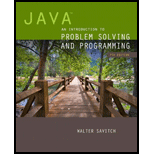
Explanation of Solution
Implementation of the derived class “CombinedDiscount”:
The implementation of the “CombinedDiscount” class derived from the “DiscountPolicy” abstract class is given below:
- • Declare the “p1”, and “p2” variables.
- • Define the constructor.
- ○ Set the values to the declared variables.
- • Define the “computeDiscount” method.
- ○ Declare the required variables.
- ○ Call the “computeDiscount” method with different variables.
- ○ Return the maximum value by checking “discount1” and “discount2” values.
- • Define the main method.
- ○ Create the objects for the “CombinedDiscount”, “BuyNItemsGetOneFree”, and “BulkDiscount” classes.
- ○ The “for” loop through 1 to10 numbers.
- ■ Call the “computeDiscount” method with objects and display the output.
The implementation of the “BulkDiscount” class derived from the “DiscountPolicy” abstract class is given below:
- • Declare the “min”, and “percentOff” variables.
- • Define the constructor.
- ○ Set the values to the declared variables.
- • Define the “computeDiscount” method.
- ○ If the purchase count is less than minimum, then calculate the “discount” value.
- ○ Otherwise make “discount” as 0.
- • Finally return the “discount” value.
- • Define the main method.
- ○ Create an object for the “BulkDiscount” class.
- ○ Call the “computeDiscount” method with different parameters and display the output.
The implementation of the “BuyNItemsGetOneFree” class derived from the “DiscountPolicy” abstract class is given below:
- • Declare the “x” variable.
- • Define the constructor.
- ○ Set the values to the declared variable.
- • Define the “computeDiscount” method.
- ○ Declare the required variables.
- ○ Calculate the “a” and “discount” values.
- ○ Return the “discount” value.
- • Define the main method.
- ○ Create an object for the “BuyNItemsGetOneFree” class.
- ○ The “for” loop through 1 to10 numbers.
- ■ Call the “computeDiscount” method with the parameter and display the output.
The creation of the abstract class “DiscountPolicy” is given below:
- • Declare the abstract method “computeDiscount” along with the two parameters “count” and “itemCost”.
- ○ This method compute and return the discount for the purchase of a given number of single item.
Program:
Filename: CombinedDiscount.java
//definition of "CombinedDiscount" class
public class CombinedDiscount extends DiscountPolicy
{
//declare the required variables
private DiscountPolicy p1;
private DiscountPolicy p2;
//definition of constructor
public CombinedDiscount(DiscountPolicy first, DiscountPolicy second )
{
//set the values
p1 = first;
p2 = second;
}
//definition of "computeDiscount" method
public double computeDiscount(int count, double itemCost)
{
//declare the required variables
double discount1;
double discount2;
//call the methods with different variables
discount1 = p1.computeDiscount(count, itemCost);
discount2 = p2.computeDiscount(count, itemCost);
//check the condition
if(discount1 > discount2)
//return the value
return discount1;
//otherwise
else
//return the value
return discount2;
}
//definition of main method
public static void main(String[] args)
{
//create the objects for the classes
DiscountPolicy buy = new BuyNItemsGetOneFree(3);
DiscountPolicy bulk = new BulkDiscount(5, 30...
Want to see the full answer?
Check out a sample textbook solution
Chapter 8 Solutions
Java: An Introduction to Problem Solving and Programming (7th Edition)
- Could you help me to know features of the following concepts: - commercial CA - memory integrity - WMI filterarrow_forwardBriefly describe the issues involved in using ATM technology in Local Area Networksarrow_forwardFor this question you will perform two levels of quicksort on an array containing these numbers: 59 41 61 73 43 57 50 13 96 88 42 77 27 95 32 89 In the first blank, enter the array contents after the top level partition. In the second blank, enter the array contents after one more partition of the left-hand subarray resulting from the first partition. In the third blank, enter the array contents after one more partition of the right-hand subarray resulting from the first partition. Print the numbers with a single space between them. Use the algorithm we covered in class, in which the first element of the subarray is the partition value. Question 1 options: Blank # 1 Blank # 2 Blank # 3arrow_forward
- 1. Transform the E-R diagram into a set of relations. Country_of Agent ID Agent H Holds Is_Reponsible_for Consignment Number $ Value May Contain Consignment Transports Container Destination Ф R Goes Off Container Number Size Vessel Voyage Registry Vessel ID Voyage_ID Tonnagearrow_forwardI want to solve 13.2 using matlab please helparrow_forwarda) Show a possible trace of the OSPF algorithm for computing the routing table in Router 2 forthis network.b) Show the messages used by RIP to compute routing tables.arrow_forward
- using r language to answer question 4 Question 4: Obtain a 95% standard normal bootstrap confidence interval, a 95% basic bootstrap confidence interval, and a percentile confidence interval for the ρb12 in Question 3.arrow_forwardusing r language to answer question 4. Question 4: Obtain a 95% standard normal bootstrap confidence interval, a 95% basic bootstrap confidence interval, and a percentile confidence interval for the ρb12 in Question 3.arrow_forwardusing r languagearrow_forward
- using r languagearrow_forwardusing r language Obtain a bootstrap t confidence interval estimate for the correlation statistic in Example 8.2 (law data in bootstrap).arrow_forwardusing r language Compute a jackknife estimate of the bias and the standard error of the correlation statistic in Example 8.2.arrow_forward
 C++ Programming: From Problem Analysis to Program...Computer ScienceISBN:9781337102087Author:D. S. MalikPublisher:Cengage Learning
C++ Programming: From Problem Analysis to Program...Computer ScienceISBN:9781337102087Author:D. S. MalikPublisher:Cengage Learning C++ for Engineers and ScientistsComputer ScienceISBN:9781133187844Author:Bronson, Gary J.Publisher:Course Technology Ptr
C++ for Engineers and ScientistsComputer ScienceISBN:9781133187844Author:Bronson, Gary J.Publisher:Course Technology Ptr EBK JAVA PROGRAMMINGComputer ScienceISBN:9781337671385Author:FARRELLPublisher:CENGAGE LEARNING - CONSIGNMENT
EBK JAVA PROGRAMMINGComputer ScienceISBN:9781337671385Author:FARRELLPublisher:CENGAGE LEARNING - CONSIGNMENT- Programming Logic & Design ComprehensiveComputer ScienceISBN:9781337669405Author:FARRELLPublisher:Cengage
 Microsoft Visual C#Computer ScienceISBN:9781337102100Author:Joyce, Farrell.Publisher:Cengage Learning,
Microsoft Visual C#Computer ScienceISBN:9781337102100Author:Joyce, Farrell.Publisher:Cengage Learning, New Perspectives on HTML5, CSS3, and JavaScriptComputer ScienceISBN:9781305503922Author:Patrick M. CareyPublisher:Cengage Learning
New Perspectives on HTML5, CSS3, and JavaScriptComputer ScienceISBN:9781305503922Author:Patrick M. CareyPublisher:Cengage Learning





